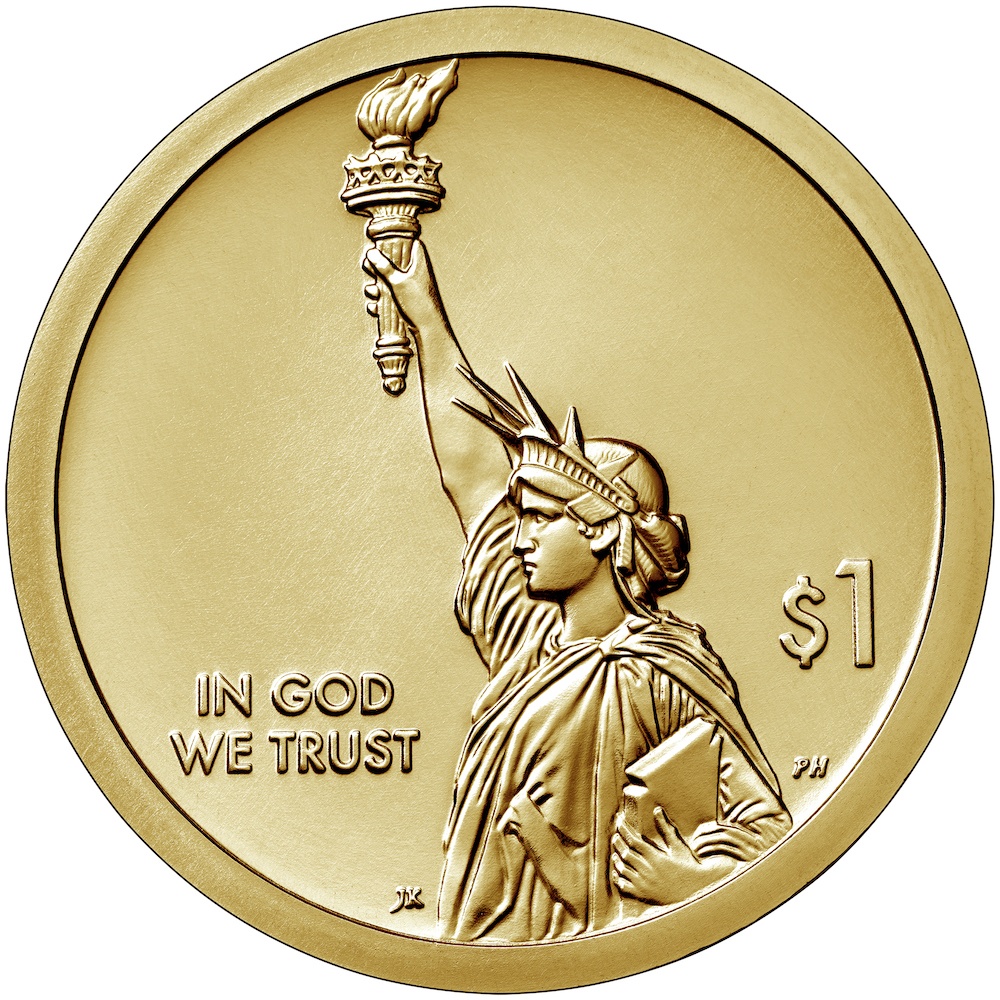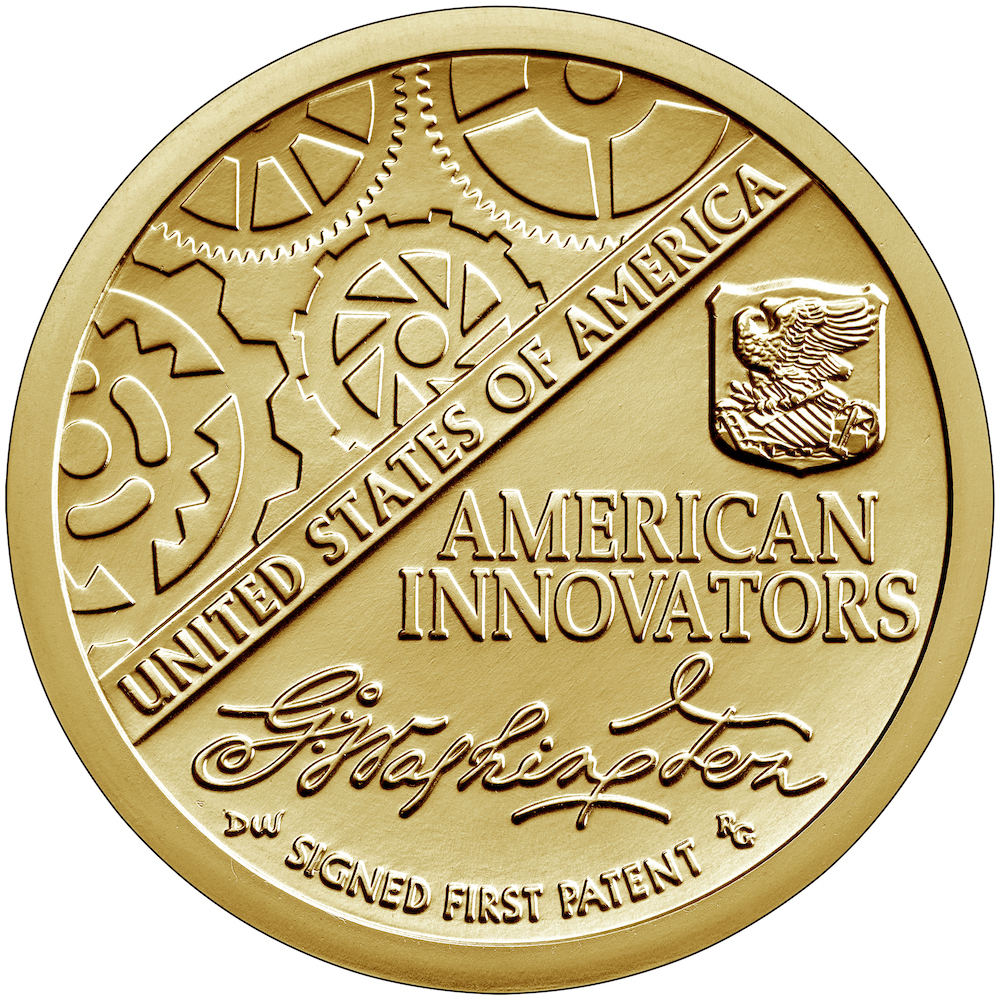Jan 22, 2019 | coins, commemorative, commentary, foreign

Staatliche Münze Berlin
(photo courtesy of Wikimedia Commons)
While the story about the currywurst commemorative coin seemed like something to poke fun at, I was reminded that Staatliche Münze Berlin, the Berlin State Mint (www.muenze-berlin.de), is not an official government mint. It is a private mint that has been contracted by the German government to assist in producing coins. Their website reports that they produce one-fifth (20-percent) of all German coins.
Reports suggest that the Staatliche Münze Berlin has been under contract to Latvia to produce legal tender coins since 2014.
It appears that Staatliche Münze Berlin would be to Germany as the Pobjoy Mint is to the United Kingdom. Both a private mints that are contracted to strict legal tender coins that create their own commemorative.
This might mean we are safe from coins commemorating poutine and haggis. However, the idea of mixing curry with ketchup may be worth a try!
Jan 20, 2019 | coins, commemorative, foreign, news
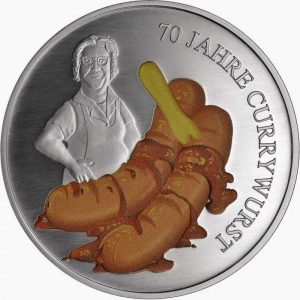
The 2019 coin commemorating currywurst has been called everything from ugly to the wurst (Image courtesy of Staatliche Munze Berlin)
Currywurst is considered the national fast food delicacy of Germany. It is a pork sausage that has been sliced part of the way through, boiled then grilled, and served smothered with ketchup mixed with curry powder. Curry powder is sprinkled on top.
According to a friend who spent time working in Germany, currywurst stands are as ubiquitous in Berlin and many other cities as hot dog stands are in New York. Depending on the stand, they can be served on buns, with sauerkraut, or fries. Since returning to the United States several years ago, he says that his family enjoys the German dish frequently.
Coins have been used to commemorate many things. Commemorating food on coins is nothing new. Coins have been used to commemorate agricultural products like wheat and corn. But aside from the (in)famous bottlecap-shaped coin, I cannot remember when a coin was used to commemorate a prepared food.
Now that the Berlin State Mint has broken this barrier, who’s next? Will the Royal Canadian Mint produce a coin honoring poutine? Or will the Royal Australian Mnt grace a coin with Vegemite? I don’t even want to think about a coin commemorating haggis!
And now the news…

January 7, 2019
Click image to enlarge MIDDLEBURY, Vt. – A coin collector from Lewiston, Maine, with no prior connection to Middlebury, has donated more than 1,000 ancient coins to the Middlebury College Museum of Art. 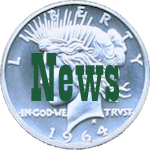 → Read more at middlebury.edu
→ Read more at middlebury.edu

January 13, 2019
A German coin manufacturer has commemorated the country’s love of currywurst with a speciality coin to mark 70 years since the savoury snack was first sold in Berlin. The silver alloy coin, made by Staatliche Munze Berlin, or the Berlin State Mint, features an image of the delicacy’s inventor alongside two giant sausages drowning in curry sauce and pierced with a wooden fork, as is tradition.  → Read more at expressandstar.com
→ Read more at expressandstar.com

January 13, 2019
A silver medal-thaler, issued by Romanian ruler Constantin Brâncoveanu in 1713, sold for USD 16,000 at a numismatic auction in New York, Profit.ro reported. Brâncoveanu, who was a prince of Wallachia between 1688 and 1714, was deposed from his throne by Sultan Ahmed III.  → Read more at romania-insider.com
→ Read more at romania-insider.com

January 13, 2019
New Delhi: A new book traces India's numismatic history through 133 rare coins which are illustrative of the country's antiquity, ethos and traditions. In Suvarna Mohur: India's Glorious History Illustrated through Rare Coins by Arun Ramamurthy, Indian history has been divided into 20 epochs.  → Read more at firstpost.com
→ Read more at firstpost.com

January 14, 2019
The Maine Bureau of Veterans’ Services (MBVS) is pleased to announce the final design selection for the new State of Maine Honorable Service coin and plaque, which will honor all Maine veterans, past and present, regardless of their branch or era of service.  → Read more at boothbayregister.com
→ Read more at boothbayregister.com

January 14, 2019
SINGAPORE: The number of coins that a buyer can use in a single transaction will be streamlined and standardised to 20 coins per denomination after Parliament passed the Currency (Amendment) Bill on Monday (Jan 14).  → Read more at channelnewsasia.com
→ Read more at channelnewsasia.com

January 14, 2019
Mobile coin exchange units are hitting the roads to encourage people to swap the loose change they have collected for easier to handle banknotes, so the coins can be recycled. The modified trucks, which are green and clearly marked with the Treasury Department logo, have a window along the side where the coins can be exchanged for notes of equal value.  → Read more at bangkokpost.com
→ Read more at bangkokpost.com

January 14, 2019
In Berlin, the participants of the most unusual robbery of recent years went on trial. Three young Arab migrants stole a considerable gold coin from the museum using only an ax handle, ropes, stairs, and carts.  → Read more at en.crimerussia.com
→ Read more at en.crimerussia.com

January 16, 2019
Greater Houston Coin Club members have been on a mission to get kids involved in the hobby.  → Read more at abc13.com
→ Read more at abc13.com
Jan 17, 2019 | advice, coins, counterfeit, errors
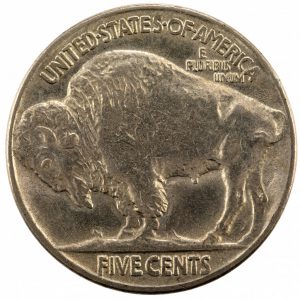 One of the more popular collector series is the Indian Head or Buffalo Nickels. Designed by James Earl Fraser, a student of Augustus Saint-Gaudens, this design was a continuation of President Theodore Roosevelt’s “pet crime” to change the look of the nation’s coinage.
One of the more popular collector series is the Indian Head or Buffalo Nickels. Designed by James Earl Fraser, a student of Augustus Saint-Gaudens, this design was a continuation of President Theodore Roosevelt’s “pet crime” to change the look of the nation’s coinage.
Introduced in 1913, the coin features a right-facing Indian head (now called a Native American head). Although there have been claims by several tribal chiefs that they were the model, Fraser’s notes suggest the image was created using the features of several men.
The reverse features the image of a buffalo, which in reality is a North American bison. The 38 different types of buffaloes live in Africa and feature larger horns similar to a longhorn steer. Most are domesticated and are raised like cattle is in the United States. Bison are largely wild animals native to the western hemisphere. Aside from their shorter horns, they have beards hanging from their chin and heavier coats that allow them to survive in colder climates.
But that has not stopped people from referring to the coin as a Buffalo nickel. It is a design so popular that when it has been used in coinage, the available supply usually sells out.
War Nickels
Before I receive a deluge of email, the Jefferson nickels struck from 1942 through 1945 were struck on a planchet made from .560 copper, .350 silver, and .090 manganese and features a large mint mark over the image on Monticello on the reverse. This was done to reduce the use of copper and nickel needed for the war effort.
Like every five-cents coin made since the introduction of the 1883 Liberty Head or “V” nickel, the planchet is made from an alloy of 75-percent copper and 25-percent nickel. Most vending machines will not be able to tell the difference between a Buffalo nickel and a Jefferson nickel.
The coin’s ability to be used in vending machines and how a worn coin could pass the unwatchful eye of a cashier, it is possible to find a Buffalo nickel in change. Although there are very few of these coins remain in circulation, avid change hunters say they can find one every 12-16 months.
This was the case when a reader found what was thought to be a 1914-D Buffalo nickel. Although not a rare or key date, a 1914-D coin could be worth upwards of $70-80 in good (G-4) condition. Finding a Denver mint coin from that year would be better than finding a Philadelphia mint coin since a coin in good (G-4) condition would be worth $16-18.
But this coin was different. Rather than having a “D” mintmark on the reverse, the “D” was backward!
-
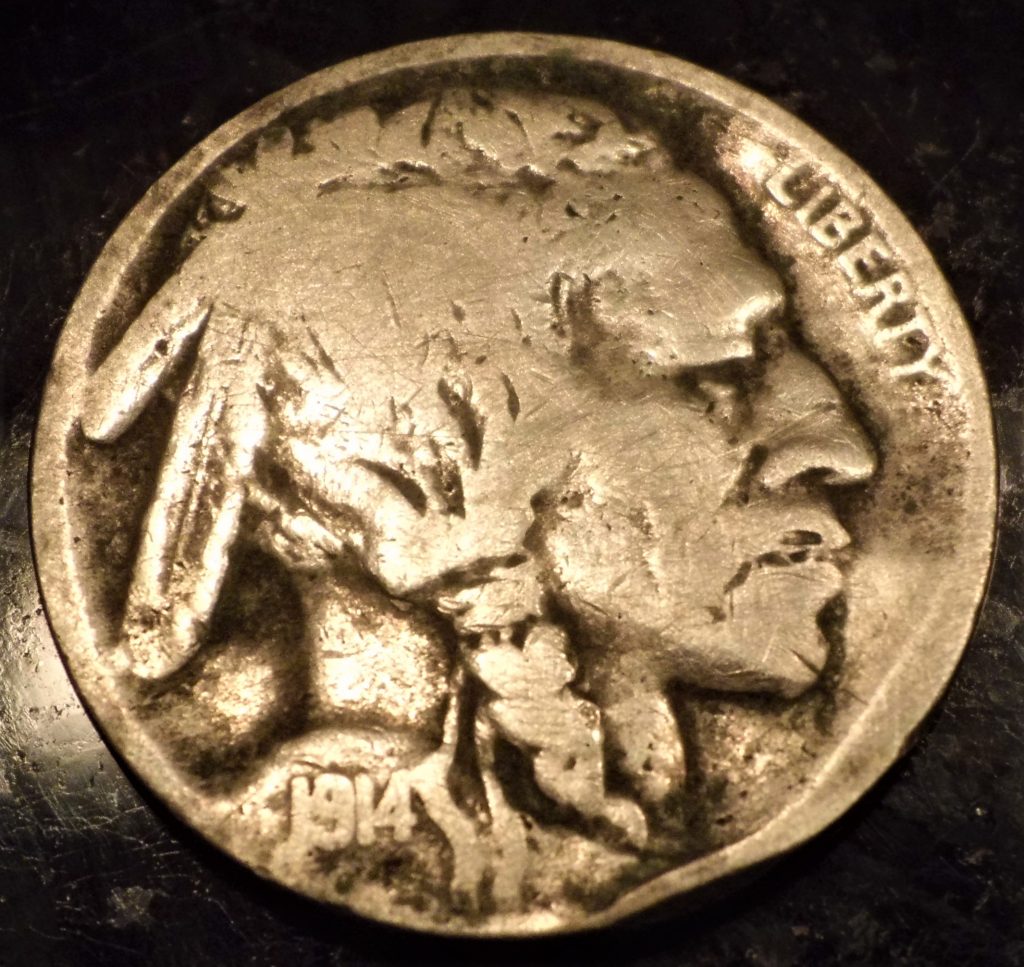
-
The found coin, a 1914-D Buffalo Nickel (obverse)
-
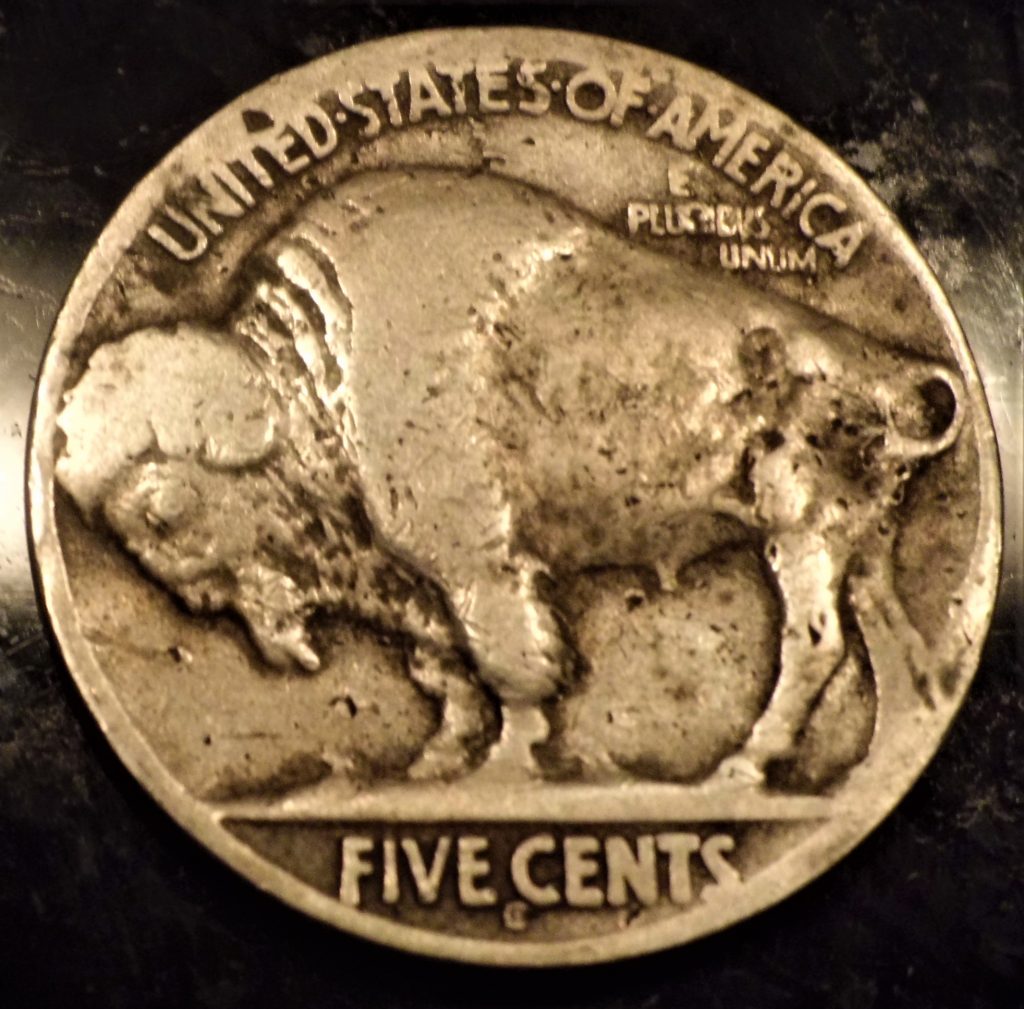
-
The reverse of the found 1914-D with an alleged “Inverted D” mintmark
Prior to the U.S. Mint creating dies with mintmarks in Philadelphia, they would send dies to the branch mints without mintmarks. The coiners at the branch mint would use a punch to imprint the mintmark into the die before striking coins. Of course, this manual process was not perfect and there are cases of mispunched, repunched, overpunched, and other such errors.
There have been cases of a mintmark that was punched horizontally into the die. Those mintmarks were repunched correctly. Coins from the San Francisco mint has had errors where the “S” is punched upside down known as an inverted mintmark. This is a fun error to find because noticing this error requires a careful eye and patience along with understanding the shape of the “S” in the font used.
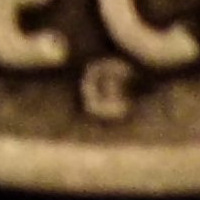
A closer look at the “inverted” D mintmark
Adding or removing mintmarks is a common method to artificially change the value of a coin. Remove the “S” from a 1921 Walking Liberty half-dollar and watch its value raise by 300-percent. Or practice adding a “D” to a 1914 Buffalo nickel to make a 400-percent profit.
After checking several references and speaking with two dealers, I sat with a box of Buffalo nickels I have to compare the mintmarks to the one on the coin. Additionally, I consulted with the images at PCGS Photograde. After all, it could be a real, undiscovered error.
The first thing I noticed on the image and with the coins I have on hand is that the mintmark on this coin is too defined for the grade. When comparing the coin to the images on Photograde, if the coin was sent in for grading it would probably be assigned a grade of G-6 of VG-8. Because of the worn rims, this coin would not grade higher than VG-8 and could be assigned a G-4.
As I was looking at the coins, those that would grade VG-8 or lower with worn rims also had mintmarks that were almost worn into the rim. In more than a dozen examples from my box, the mintmarks on all of the low-grade coins showed the rims and mintmark worn together.
Another aspect of the mintmark that bothered me was that the “D” seemed smaller than those on the coins I was looking at. For comparison, I pulled out my album with higher grade Buffalo nickels and found that the mintmark was similar in size to those in higher grades.
-
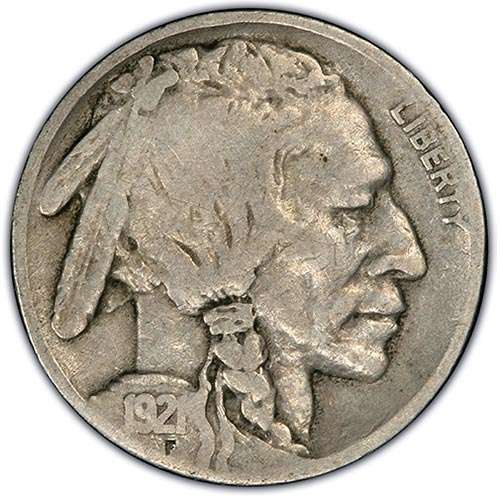
-
According to PCGS Photograde, this 1921 Buffalo Nickel represents a VG8 grade.
-
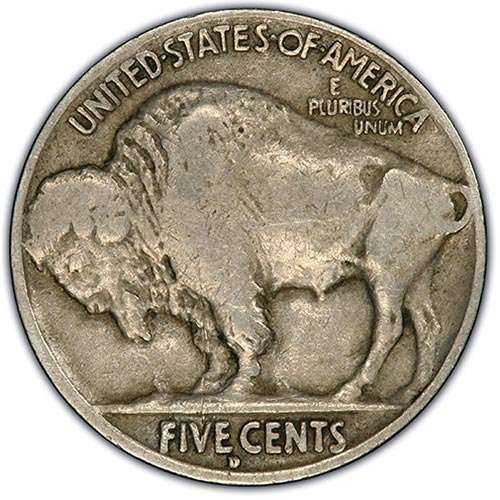
-
Look at the “D” mintmark on this 1929-D nickel graded F12 as part of PCGS Photograde
Then there is the coloring around the mintmark. Comparing it to the examples in my box, the dirt patterns around the “D” seems off. While the coloring around all of the letters appears to be uneven, there appears to be a consistent line around the “D.” In fact, the coloring at the bottom of the “D” is inconsistent with that of the other letters around it.
If I had the coin in hand, I would be able to examine it closer with a 15x loupe. I would even attempt to pick at it with a toothpick to see if the “D” would fall off. However, given all of the issues with the coin based on the images alone, I am reasonably certain that the “D” was added by someone outside of the U.S. Mint.
Of course, if you have your own theories then please post them as a comment, below.
PCGS Photograde images courtesy of PCGS and can be found
here.
Jan 13, 2019 | Australia, coins, commemorative, news, US Mint
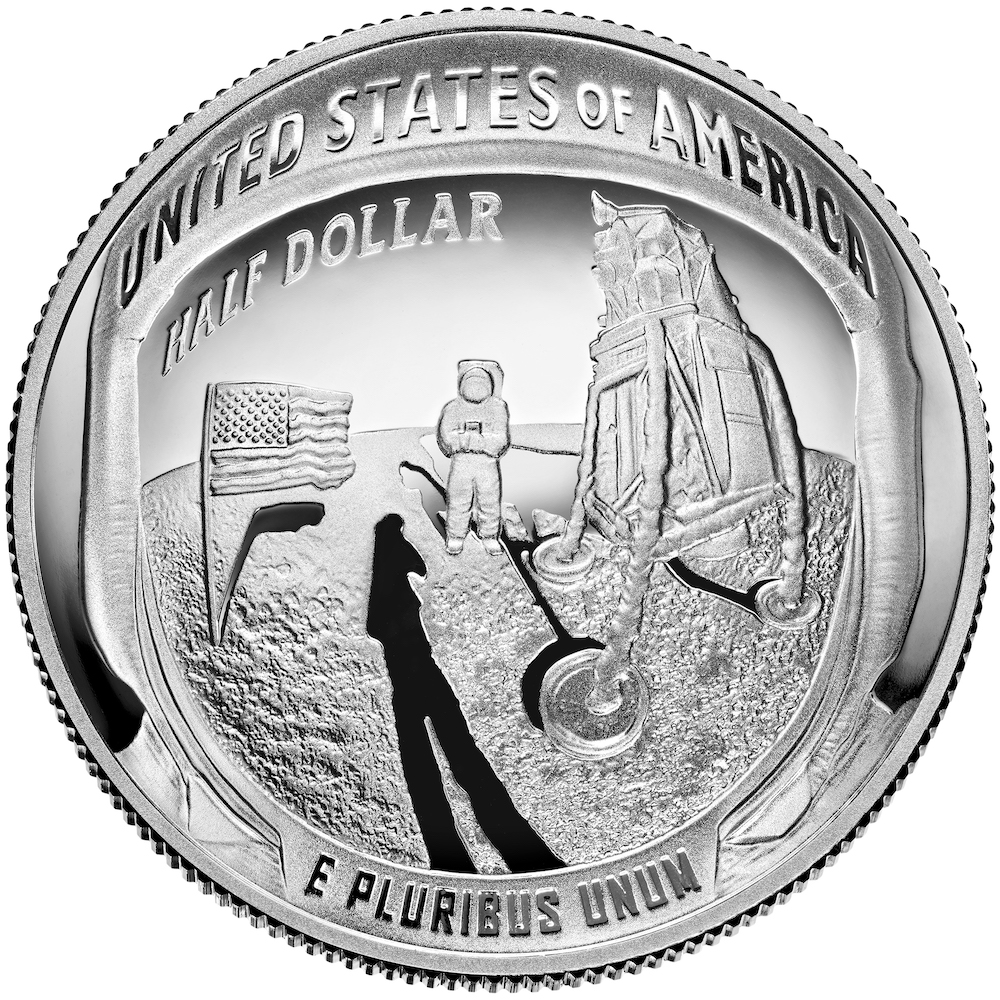 Pairing U.S. coins with a foreign coin for sale has been done in the past by the U.S. Mint. In 2002, the U.S. Mint offered the “Legacies of Freedom” This week, the U.S. Mint announced a collaborative project with the Royal Australian Mint to produce a commemorative coin set in celebration of the 50th Anniversary of the Apollo 11 Moon landing. The set will feature a U.S. Apollo 11 50th Anniversary Half Dollar paired with an Australian 50th Anniversary of the Moon Landing 1 oz. $5 Silver Coin.
Pairing U.S. coins with a foreign coin for sale has been done in the past by the U.S. Mint. In 2002, the U.S. Mint offered the “Legacies of Freedom” This week, the U.S. Mint announced a collaborative project with the Royal Australian Mint to produce a commemorative coin set in celebration of the 50th Anniversary of the Apollo 11 Moon landing. The set will feature a U.S. Apollo 11 50th Anniversary Half Dollar paired with an Australian 50th Anniversary of the Moon Landing 1 oz. $5 Silver Coin.
The announcement noted that the set will be produced and sold by the Royal Australian Mint with marketing help from the U.S. Mint who will put a link on their website.
set. A limited edition of 50,000 sets that included an uncirculated American Silver Eagle $1 coin and a £2 Silver Britannia from the Royal Mint. These sets were created and marketed by the U.S. Mint with a price of $49.88 per set, noting that the spot price of silver was $6.39 per troy ounce.
Prior to that, the U.S. Mint produced the 2000 Leif Ericson Millennium Commemorative Set that included a 2000 Leif Ericson Proof Silver Dollar and a 1000 Kronur proof silver coin produced by the U.S. Mint for Iceland. It was the last coin the U.S. Mint produced for a foreign government. The U.S. Mint sold 86,136 sets at a price of $63 per set.
Since the set will be produced by the Royal Australia Mint, there are questions regarding the opportunities that may be missed by the U.S. Mint to do the same. For example:
- The press release says that it will be a “limited production set” but does not specify how many sets will be produced.
- Other than the legal requirements that the U.S. Mint shall not lose money on a commemorative coin program and that the half-dollar includes a $5 surcharge, what are the financial arrangements between the two government mints?
- Who will handle the fulfillment of orders from the United States? Those who have purchased items from Australia and New Zealand know that the because of shipping and customs restrictions, items can take 6-8 weeks to enter the United States before it can be given to the Postal Service for delivery.
These questions will be addressed to the U.S. Mint as soon as Tuesday. Even though the U.S. Mint continues to operate during the shutdown, offices in Washington, D.C. will be closed on Monday because of 8-12 inches of snow that covers the region.
And now the news…

January 5, 2019
Coins expected to bring increased security to economies of British territories and dependencies  → Read more at theguardian.com
→ Read more at theguardian.com

January 9, 2019
A penny that a Massachusetts teenager found in his change from lunch money could be worth as much as $1.65 million (£1.3 million) when it is auctioned off.  → Read more at foxnews.com
→ Read more at foxnews.com

January 9, 2019
My grandfather was a numismatist. William Evans Mullan II died over the weekend. The coin collection lives on.  → Read more at djournal.com
→ Read more at djournal.com

January 10, 2019
Don Lutes Jr. kept the 1943 copper penny he stumbled upon in his high school cafeteria seven decades ago in a safe behind a wall in his Massachusetts home.  → Read more at cnn.com
→ Read more at cnn.com

January 11, 2019
Jim Cramer shares his favorite ways to add gold to a portfolio and encourages investing in the precious metal if you’re nervous about 2019.  → Read more at cnbc.com
→ Read more at cnbc.com

January 11, 2019
BERLIN — Four young men have gone on trial over the brazen theft of a 100−kilogram Canadian gold coin from a Berlin museum.  → Read more at manitobapost.com
→ Read more at manitobapost.com
Jan 3, 2019 | coins, commemorative, legislative
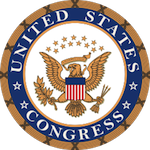 It should come as no surprise to anyone that the 115th Congress left unfinished business. As we start the new year, 25-percent of the executive branch does not have the legal funding to operate. Those with leftover funds operated as long as they could but are now closed pending congressional action.
It should come as no surprise to anyone that the 115th Congress left unfinished business. As we start the new year, 25-percent of the executive branch does not have the legal funding to operate. Those with leftover funds operated as long as they could but are now closed pending congressional action.
As with previous shutdowns, the U.S. Mint and the Bureau of Engraving and Printing are not affected. Both agencies are self-funded from their profits (seigniorage) which is held in their respective Public Enterprise Funds.
The 115th Congress is constitutionally scheduled to end at 12:00 noon on January 3, 2019, when the 116th Congress will begin. Congress will take up the new funding bills as part of the opening session.
When the new Congress gavels into session, any bill pending from the 115th Congress will be removed from the docket. It will be said that these bills will die in committee.
In reviewing December’s legslation update, there was the passage of one bill:
H.R. 1235: Naismith Memorial Basketball Hall of Fame Commemorative Coin Act
Summary: (Sec. 3) This bill directs the Department of the Treasury to mint and issue not more than 50,000 $5 coins, 400,000 $1 coins, and 750,000 half-dollar coins in recognition and celebration of the Naismith Memorial Basketball Hall of Fame.The coins shall be in the shape of a dome, and the design on the common reverse of the coins shall depict a basketball. Treasury shall hold a competition to determine the design of the common obverse of the coins, which shall be emblematic of the game of basketball.(Sec. 7) The bill requires all sales of such coins to include specified surcharges, which shall be paid by Treasury to the Hall to fund an endowment for increased operations and educational programming.
Message on Senate action sent to the House. — Dec 19, 2018
Presented to President. — Dec 19, 2018
Passed Senate without amendment by Voice Vote. — Dec 18, 2018
Senate Committee on Banking, Housing, and Urban Affairs discharged by Unanimous Consent. — Dec 18, 2018
Received in the Senate and Read twice and referred to the Committee on Banking, Housing, and Urban Affairs. — Sep 26, 2017
Motion to reconsider laid on the table Agreed to without objection. — Sep 25, 2017
On motion to suspend the rules and pass the bill, as amended Agreed to by voice vote. — Sep 25, 2017
DEBATE – The House proceeded with forty minutes of debate on H.R. 1235. — Sep 25, 2017
Considered under suspension of the rules. — Sep 25, 2017
Mr. Barr moved to suspend the rules and pass the bill, as amended. — Sep 25, 2017
Referred to the House Committee on Financial Services. — Feb 27, 2017
The Naismith Memorial Basketball Hall of Fame Commemorative Coin Act was sent to the White House for presidential signature on December 19, 2018. The president has ten days to act on the bill. He can sign the bill, which there is no indication that he has, and it becomes law. He could veto the bill to prevent it from becoming law.
But what if he does not sign the bill? If Congress was still in session then the bill automatically becomes law. If Congress adjourned then the bill does not become law. That is called a pocket veto.
Because of the shutdown, Congress did not adjourn while trying to resolve the issue. There were pro forma sessions, meaning that a representative gaveled in the House and Senate only to adjourn for the day. If the president did not sign or veto the bill, it has become public law. However, since the Government Printing Office (GPO), the official publisher of the U.S. government, is closed because of the shutdown, they cannot publish the results of legislation passed or vetoed. Therefore, we do not know whether this bill is now the law.
Previous administrations would announce bill signings in their regular news streams. This White House has chosen to discontinue that practice leaving us at the mercy of the currently closed GPO.
In December, the Senate passed the National Law Enforcement Museum Commemorative Coin Act by a voice vote. Although the bill was sent to the House for consideration it never left the committee and will die in committee when the 116th Congress is gaveled into session.
S. 2863: National Law Enforcement Museum Commemorative Coin Act
Held at the desk. — Dec 19, 2018
Received in the House. — Dec 19, 2018
Message on Senate action sent to the House. — Dec 17, 2018
Passed Senate without amendment by Voice Vote. — Dec 13, 2018
Senate Committee on Banking, Housing, and Urban Affairs discharged by Unanimous Consent. — Dec 13, 2018
Read twice and referred to the Committee on Banking, Housing, and Urban Affairs. — May 16, 2018
Finally, Rep. Bruce Poliquin (R-ME), whose district includes Kennebunkport, introduced the President George H. W. Bush and Barbara Bush Dollar Coin Act. Essentially, this would have extended the Presidential $1 Coin program to include President George H.W. Bush and First Lady Barbara Bush. This bill, like many others, died in committee.
H.R. 7257: President George H. W. Bush and Barbara Bush Dollar Coin Act
Referred to the House Committee on Financial Services. — Dec 11, 2018
A full review of the 115th Congress will be published shortly after the government reopens and the GPO resumes its publishing operations.
Dec 30, 2018 | coins, markets, news
While considering the news of the past week, the one thing that sticks out is the press release from the Professional Numismatic Guild. The release touts the strength of the high-end, rare coin market with a throwaway line that notes there may trouble for the general collector.
While prices declined during the year for some U.S. coins in easily available lower grades, hundreds of noteworthy coins from early American to modern that are among the finest known of their kind set auction price records….
Prices for collector coins are driven by two principles: the spot price of silver and other metals that were used to strike the coins; the ability for the supply to meet the demand.
Primary spot price that drives the general collector coin market is silver. Silver opened on January 2, 2018, at $17.06 per troy ounce. On Friday, December 28, the price of silver was $15.29. This is a decline of $1.80 for the year or 10.55-percent decrease. This is not something that has occurred in the last month as the stock market had problems. Silver reached its highest price on January 15 when it reached $17.325. The spot price of silver dropped below $17.00 on February 5 and has been on a steady decline all year.
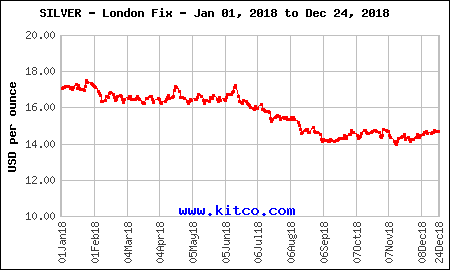
There has been a steady decrease in the spot prices of silver in 2018
(chart courtesy of Kitco; this is a static chart and will not update)
But the price of silver alone is not enough to drive collector coin prices down to get PNG’s attention. The problem is the other part of the equation: supply and demand.
The supply of collector coins is not changing. The coin market is relatively stagnant since the U.S. Mint is no longer making Mercury dimes, Walking Liberty half dollars, or Morgan dollars. There may be an increase in those coins coming to the market as collectors liquidate or the families of deceased collectors liquidate, but is this more than usual?
The number of people collecting may not be enough to drive the market simply because numismatics is not as popular a hobby as it once was.
PNG notes that the success of their high-end business may be coming from investors, not collectors:
“With the stock market dropping during the fourth quarter of 2018 we saw an increase in interest in the rare coin market with some people taking profits from stocks and buying coins that have proven to show sizeable and consistent increases in value over the years, as well as buying precious metals,” said Professional Numismatists Guild President Barry Stuppler.
While it is good that the PNG touts the work of their members in the Top 10% of the market, the general public is not buying. PNG can pat themselves on the back all they want but if they are not helping the entire industry, they are losing the opportunity to turn a general collector into one of their customers.
Further, the American Numismatic Association, which is dominated by the same dealers who are members of the PNG, seem to have a blind spot that prevents them from seeing the general collector as a viable business model to cultivate.
There are only so many times that the industry can claim successes by selling the same 1913 Liberty Head Nickel before everyone, including investors, consider this a market with stale inventory.
This is not to say that the PNG dealers are bad people or have bad intentions. This is saying that the PNG needs to look beyond the top 10-percent of the market to ensure the other 90-percent is just as healthy. Without a market balance and without market diversity, the hobby will be in trouble. Even in the equity markets, low volume low capitalized stocks can cause harm to the market.
And now the news…

December 24, 2018
JEDDAH: The Kingdom’s fiscal trajectory in many ways mirrors the tribulations it endured before emerging as one of the world’s foremost trade and financial hubs. Before the Kingdom was unified by its late founder, King Abdul Aziz, the Arabian Peninsula had suffered its fair share of economic woes thanks to war and political strife within tribal factions.  → Read more at arabnews.com
→ Read more at arabnews.com

December 25, 2018
Coinages issued in Maharashtra dating back to 2600 BCE on display  → Read more at thehindu.com
→ Read more at thehindu.com

December 25, 2018
Gold prices advanced for a second straight day on Tuesday and rose Rs 125 on higher demand from local jewellers  → Read more at livemint.com
→ Read more at livemint.com

December 27, 2018
In a sign of precious metals demand, sales of U.S. Mint American Eagle gold and …  → Read more at reuters.com
→ Read more at reuters.com

December 27, 2018
Earlier this month, my friend Hugo Salinas Price emailed an interesting story about a single gold coin that that he still holds dearly. As I was shuffling papers in some old files, I came across a slip of paper on which I had written down the price I had paid for a Mexican $50 gold peso coin: 717 Mexican pesos.  → Read more at moneymaven.io
→ Read more at moneymaven.io

December 27, 2018
Israel Antiquities Authority, JNF and Border Police stopped a band of thieves from stealing ancient coins from the Hukuk Synagogue archeological site in northern Israel on Thursday. "A quick response prevented damage to the magnificent and important treasures of the site," Nir Distelfeld, the antiquities theft inspector, said.  → Read more at jpost.com
→ Read more at jpost.com

December 28, 2018
Operators of the historic Coin Press No. 1 inside Carson City's Nevada State Museum began striking silver medallions Friday with a commemorative Abraham Curry design created just for the occasion. On the last Friday of each month, the Nevada State Museum runs the coin press, which now mints unique collectible medallions.  → Read more at carsonnow.org
→ Read more at carsonnow.org
Dec 22, 2018 | coins, grading, news
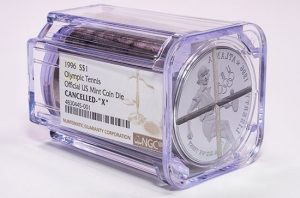
1996 Olympic Tennis Commemorative silver dollar “X” cancelled die encapsulated by NGC (Image courtesy of NGC)
Fees for this service range from $20 for a defaced die to $50 for a die that was canceled with an “X” to $100 for a die that was not canceled.
The holder appears to be similar to those used to encapsulate rolled coins. It will hold a die up to 40.6mm wide and 59.6mm tall, likely the largest die that the U.S. Mint would use to strike coins. The holder will be too small for the dies that would have struck 3-inch medals.
NGC does not say how the holders would keep smaller dies in place.
NGC will accept coin dies from any country.
Since I found coin dies interesting, I bought a few. Two Lincoln cent dies were ground down except still have a small part of the design visible. The other is a 1994 half-dollar obverse die. The one cent dies are on my desk at home and the half-dollar dollar dies is in my office.
-
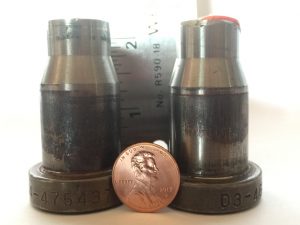
-
Lincoln Cent Dies from the Denver Mint
-
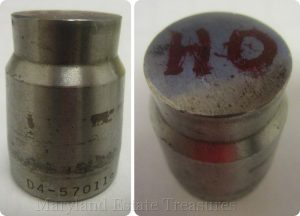
-
Canceled obverse die from a 1994-D Kennedy Half Dollar
Having the die sitting on my desk is a great conversation starter. Visitors will ask what it is and when I explain they have the same reaction that I had when I bought it at the 2018 World’s Fair of Money: “ooo, neat!”
I am not sure how I feel about this news for the industry but I will not be submitting my dies for encapsulation. I do not think the die’s industrial look would look good entombed in plastic.
Dec 20, 2018 | coin design, coins, dollar, US Mint
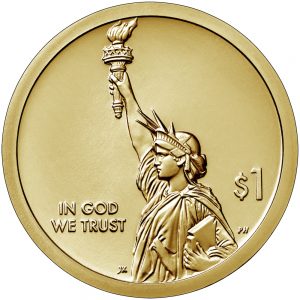 Since U.S. Mint announced the launch of the American Innovation $1 Coin Program there has been nothing but complaints from the community about the coin.
Since U.S. Mint announced the launch of the American Innovation $1 Coin Program there has been nothing but complaints from the community about the coin.
According to the law (Public Law No: 115-97), “The common design on the obverse of each coin issued under this subsection shall contain a likeness of the Statue of Liberty extending to the rim of the coin and large enough to provide a dramatic representation of Liberty.” With the U.S. Mint under a short deadline because of when the bill became law (July 20, 2018), there were a number of disagreements with the Citizens Coinage Advisory Committee regarding the obverse design of the coin. The U.S. Mint tried to modify an old design but the CCAC did not like that. Eventually, the design from Miss Liberty’s left side was used.
It has turned out to be an elegant design that does not duplicate any previous one. She stands on the coin as stately as she stands in New York Harbor, extending from rim to rim as required by law. For once, the CCAC and I agree on a good design.
But that is not enough for some people. The design is too plain.
The reason why the coin appears plain is that two elements that could have been on the obverse, the date and motto “E Pluribus Unum,” are on the edge of the coin.
Edge lettering for the $1 coins began in 2007 with the introduction of the Presidential $1 Program. It was decided to move these elements, along with “In God We Trust” to the edge because the obverse was to include the years of the president’s term. Aside from providing more space for the design, relocating the date would prevent potential confusion as to the date of the coin.
“In God We Trust” was restored to the obverse of the coin in 2009 after striking errors caused the edge of the coin to be blank. This caused overzealous conspiracy theorists and the gullible believing that this was done purposely against the religious communities.
Some argue that since the conditions have changed, the coin should not have edge lettering.
Aesthetically, the obverse design was well executed. It would be how the statue would look if you were standing in Battery Park located at the southern tip of Manhattan, and looked across the water on a clear day. There should be no reason to change the design.
However, there is a problem with the edge lettering in that it makes it difficult to see. As someone who has reached the age where an annual eye exam is a requirement and “corrective lenses” is now a permanent fixture on my driver’s license, having the mintmark on the edge requires me to use magnification to find the mintmark.
As a member of the Baby Boomer generation whose glasses seem to get stronger every year, I would be in favor of moving the date and mintmark to the obverse of the coin. But if the problem is only aesthetics, then I have no problems with having to use a 16x loupe to help identify where the coin was struck.
Dec 16, 2018 | coins, commemorative, dollar, news, US Mint
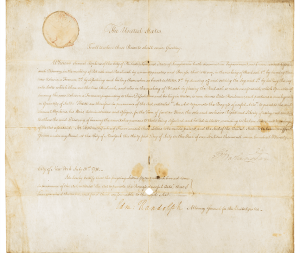
Patent X1 issued to Samuel Hopkins and signed by President George Washington on July 31, 1790 (USPTO Image)
On July 31, 1790, Samuel Hopkins was granted patent number X00001 for this method “in the making of Pot ash and Pearl ash by a new Apparatus and Process.” In June of this year, the U.S. Patent and Trademark Office (USPTO) issued Patent #10,000,000 based on the current numbering system that began in 1836. According to the USPTO, there were 9,433 patents issued from 1790 through 1835.
The other news from the U.S. Mint was the first strike ceremony for the Apollo 11 50th Anniversary Commemorative Coins at the Philadelphia Mint. Children of the three astronauts who flew on Apollo 11 represented their fathers at the ceremony: Mark Armstrong, Andrew Aldrin, and Ann (Collins) Starr.
Coins will be offered for sale to the public on January 24, 2019. The money raised from this commemorative coin program will benefit the Astronauts Memorial Foundation, the Astronaut Scholarship Foundation and the Smithsonian National Air and Space Museum’s “Destination Moon” gallery.

A pair of 5-ounce silver proof $1 coins struck during the First Strike Ceremony at the U.S. Mint (photo courtesy of collectSPACE.com)
And now the news…

December 10, 2018
Cash use has plummeted in Australia over the last few years but Eric Eigner isn't worried. "People will want to collect something that appears to be more scarce," he says. "I think it's a good thing to a certain extent."  → Read more at smh.com.au
→ Read more at smh.com.au

December 10, 2018
The patterns on Guangxi commemorative coins reveal special cultural elements and how the region has developed in the past 60 years.  → Read more at news.cgtn.com
→ Read more at news.cgtn.com

December 10, 2018
Museum intern Roo Weed ’18.5, a physics major, is using digital solutions to make the College’s rare coin collection more accessible to the public.  → Read more at middlebury.edu
→ Read more at middlebury.edu

December 11, 2018
"> <META PROPERTY=  → Read more at miningnewsnorth.com
→ Read more at miningnewsnorth.com

December 14, 2018
From Alexander the Great to the Byzantium and the Middle Ages until the modern era all periods are covered in an exhibition featuring a rare collection of gold coins. This collection contains coins that are considered to have paved the way for the use of coins in world history and is being staged by the …  → Read more at cyprus-mail.com
→ Read more at cyprus-mail.com

December 14, 2018
The United States Mint reveals a new coin collection to commemorate the 50th anniversary of the Apollo 11 moon landing. Item includes great video of striking coins in the mint  → Read more at myhighplains.com
→ Read more at myhighplains.com

December 15, 2018
The U.S. Mint has struck its initial coins commemorating the 50th anniversary of the first moon landing. You could say it was one small strike for the Mint, one not-so-giant press for Apollo history. The coins were stamped as part of a "first strike" ceremony.  → Read more at collectspace.com
→ Read more at collectspace.com

December 15, 2018
The finds are "of great benefit" in helping understand Wales' "unique history", National Museum Wales says.  → Read more at bbc.com
→ Read more at bbc.com
Dec 14, 2018 | coins, dollar, US Mint
Later today, the U.S. Mint will have a ceremony to begin the American Innovation $1 Coin Program. The ceremony is scheduled for 11:30 am at the U.S. Mint’s headquarters at 801 9th Street NW in Washington, D.C.
The American Innovation $1 Coin Program will issue four dollar coins a year in recognition of the significant innovation and pioneering efforts of individuals or groups from each of the 50 States, the District of Columbia, and the United States territories. Coins will be issued in the order that the states entered the union followed by the District of Columbia, Puerto Rico, Guam, American Samoa, the U.S. Virgin Islands, and the Northern Mariana Islands.
As allowed by law (Public Law 115-197), the U.S. Mint is producing an introductory coin for the program that will be presented as part of the launch.
The obverse of the coin, which will be featured throughout the series, is a view of the Statue of Liberty in profile. The view of the upper third of her body with the torch extended to the edge of the coin with a plain background gives the image a quiet elegance that is not usual for a U.S. Mint design. It was designed by Justin Kunz of the Artistic Infusion Program with credit to the Citizens Coinage Advisory Committee for pushing the U.S. Mint to come up with something different.
The reverse design of this introductory coin provides hope that the future of this program will not be mired in trite designs. It honors American Innovation by recognizing the first U.S. patent signed by President George Washington that was issued to Samuel Hopkins on July 31, 1790, for developing a process for making potash. The gears representing innovation appears next to Washington’s autograph.
The year, mint mark, and E PLURIBUS UNUM (Out of many, one) will appear on the edge of the coin as it does with all $1 coins since 2007.
Although it is a fantastic design worthy of a collection that includes the Native American Dollar designs, it will have the same impact as all dollar coins issued in the 21st century. It is a coin that will barely circulate and will not grab the attention of the U.S. public without its circulation.
Even though Congress creates these programs and has been told that this program will be a failure because the coins will not circulate alongside the paper dollar, they continue as if nothing is wrong. Even the Government Accounting Office, their own agency that helps with investigations and oversight of the federal government, has recommended eliminating the one-dollar note.
I will collect these coins as I have done for all of the special series introduced in the 21st century. But I will not be as enthusiastic about this series as I should be until something is done to make these coins circulate.


 → Read more at
→ Read more at 






 It should come as no surprise to anyone that the 115th Congress left unfinished business. As we start the new year, 25-percent of the executive branch does not have the legal funding to operate. Those with leftover funds operated as long as they could but are now closed pending congressional action.
It should come as no surprise to anyone that the 115th Congress left unfinished business. As we start the new year, 25-percent of the executive branch does not have the legal funding to operate. Those with leftover funds operated as long as they could but are now closed pending congressional action.






